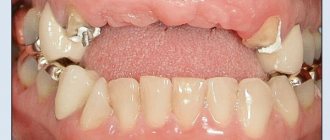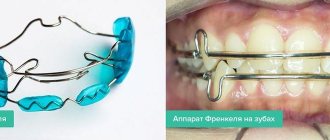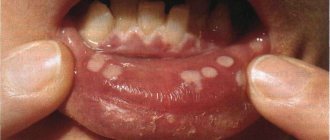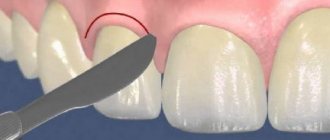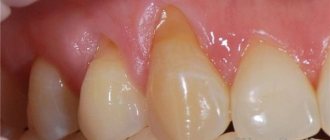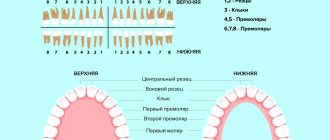In the modern world, good appearance gives many bonuses. All other things being equal, a beautiful person will be liked more by others, so he will always be in more favorable circumstances. A smile is very important. Even the most pleasant person, if her teeth are far from perfect, can make a repulsive impression. Therefore, if everything is not ok with dentistry, it’s worth doing it. Of course, it all depends on what exactly is wrong and how severe the manifestations are. For example, a gummy smile - it even suits some people. Well, someone with this feature looks simply disgusting.
Causes of gummy smiles in children and adults
In adults, a gummy smile is quite rare, since this problem in most cases appears in childhood. There are several known main reasons for the appearance of this problem: improper development of the facial skeleton, a short upper lip that cannot cover the gum, or, on the contrary, an overly large gum that covers the upper row of teeth more than necessary. At the same time, a strongly pronounced gummy smile, as a rule, is a consequence of malocclusion, or anomalies in the development of the maxillofacial skeleton.
Methods for correcting a gummy smile
There are many techniques for restoring the aesthetics of a smile. The choice of treatment method depends on the cause of the defect. Effective methods for correcting a gummy smile include:
- Using Botox.
- Lip augmentation in volume.
- Changing the length of the bridle.
- Laser correction.
- Changes in the perioral muscles.
- Orthodontic treatment.
Therapy is prescribed by a doctor after collecting an anamnesis of life and pathology. In this case, the individual characteristics and wishes of the patient are taken into account.
Gingival smile correction with Botox
Botulinum toxin can help correct gum deficiency. This correction is considered the simplest method of therapy. A cosmetologist injects medicinal Botox into the area of the nasolabial folds. This reduces the sensitivity of local nerve endings. The upper lip becomes inactive, and the gingival margin is no longer exposed.
To obtain long-term results, the procedure is carried out at intervals of 1 time every 4–6 months. The advantages of Botox in the treatment of gums are the safety of the drug and the ease of manipulation.
Increased lip volume
Due to the possibility of a radical change in appearance, not all patients agree to this type of treatment. The purpose of the procedure is to augment the lips and further close the papillary marginal gingiva.
Biodegradable and biopolymer preparations can serve as biogels. The first option has a short-term effect, the second option lasts about a year and a half.
Trimming the frenulum of the upper lip
You can reduce the mobility of the upper lip and reduce the impact on the gums using plastic correction of the frenulum. The operation is performed in a dental clinic by a surgeon. Before the procedure, consultations with an orthodontist and a dental therapist are recommended.
Laser Application
Laser gum correction is used quite often. Excision of excess gum is performed under local anesthesia. Thanks to the laser beam, it becomes possible to create a clear contour of the gingival margin and prevent intraoral bleeding. The surgical operation takes no more than 30 minutes, and rehabilitation takes about 10 days.
Correcting a pink smile with braces
Orthodontic treatment is indicated in cases where the cause of a gummy smile is crowded teeth and an abnormal bite. Corrective devices and braces allow you to straighten the pink smile zone and move the teeth to the required place.
As a rule, wearing orthodontic structures takes no more than 2–3 years. If necessary, additional correction methods are prescribed (surgical, cosmetic).
Plastic surgery of the orbicularis oris muscle
Despite its high effectiveness, this treatment method is used extremely rarely. Under local anesthesia, an incision is made above the upper lip, after which the muscles surrounding the oral cavity are sutured together with a flap of the mucous membrane.
The disadvantages of this method are increased trauma and prolonged healing of soft tissues.
Facial skeleton reconstruction
Used only when all other methods of therapy are useless. In case of deformation of the facial skeleton, osteotomy and ostectomy are performed. In this case, the upper teeth are moved to the correct location, and the lower jaw is fixed at the required angle.
The operation is performed in a hospital setting under the supervision of attending physicians.
Reconstructive surgery in the treatment of gummy smiles
In situations where a gummy smile appears as a result of abnormal development of the facial skeleton, the only effective solution to the problem is surgery. For these purposes, osteotomy (correction of the upper jaw) and ostectomy (operation performed to correct the lower jaw) are used.
In the vast majority of cases, such surgical interventions are carried out in the presence of serious anomalies in the development of the bite, but can also be performed in the normal position of the jaws, for example, to correct a gummy smile.
What is a gummy smile
Gummy smile (Gummy Smile) is an aesthetic defect that represents the opening of the papillary-marginal gum in the smile zone. When a person suffering from this problem smiles, a large amount of gum is visible above the front teeth. What are the causes of a gingival smile, and what methods are there for correcting the gingival margin?
According to statistics, more than 20% of the world's population have a gummy smile. During contraction of the orbicularis oris muscles, not only the front incisors of the upper jaw are exposed, but also part of the gum tissue. It must be remembered that exposure of the gum edge is not always considered a pathology. A reason for concern and a visit to the doctor may be gums that are visible in the smile area by more than 3 mm.
Causes of a gingival smile
As a rule, a gingival smile defect occurs due to congenital anomalies that appear in childhood. A gummy smile in a child is not considered a rare occurrence.
Cases where gums are visible when smiling in adults are much less common. Basically, such problems appear due to mechanical influences or unsuccessful plastic interventions.
The reasons why gums become exposed when smiling include:
- violations of the structure of the upper or lower jaw;
- bite pathologies;
- crowded teeth;
- heaviness of the muscles of the upper lip;
- dysfunction of the circular muscles;
- increased wear of the anterior incisors;
- gum hyperplasia associated with bacterial infection;
- pathology of the frenulum of the upper lip;
- thin lips;
- the location of the upper jaw is above the normal physiological level.
Indications for correction of a gummy smile
Since gum deficiency does not cause discomfort and does not cause complications, many patients and dentists ignore this gum problem. In 80% of cases, the cause of rapid correction of oral gums is a violation of the appearance of the smile and gum growth.
The main indication for correction of a gummy smile is the presence of infectious and inflammatory diseases of the oral gingival mucosa. Due to the increase in the gingival margin, difficulties arise in carrying out hygienic measures, the amount of mineralized and soft dental plaque increases, and unpleasant symptoms of gingivitis and periodontitis appear.
Indications for correction
Since such a smile does not in any way affect human health and the condition of the oral cavity, dentists rarely refer patients to mandatory surgery for this reason. Usually a person himself wants to improve his appearance and asks a specialist about it.
The correction procedure can also be carried out in conjunction with other types of treatment. For example, if an incorrect bite is detected, then after orthodontic treatment the smile will automatically improve. Or, during surgery for diseases of periodontal tissues, part of the overgrown gums can be removed, thereby exposing the incisors to normal sizes.
Causes of a gummy smile
A gummy smile is a smile in which the gums open more than 2-3 mm. The defect is a congenital anatomical feature and occurs in approximately 15% of people in the world. This disadvantage occurs for three main reasons:
- Hyperactivity of the muscles of the upper lip, causing it to rise too high when smiling.
- Excessively large gums that cover the teeth too much, causing them to appear shorter than they actually are.
- Deformed bones of the facial skeleton. With such a defect, the lower or upper jaw usually moves forward.
Depending on the cause of development, eliminating a gummy smile can be done in several ways.
What procedures are improved by laser?
Correction of the frenulum - frenuloplasty
When a child or adult requires a frenulum correction, there are two ways to perform the procedure: with a scalpel or a dental laser. Laser frenulum correction has undeniable advantages:
- almost complete painlessness, light application anesthesia is enough and no injection is required
- bloodlessness, because the laser beam does not cut, but evaporates tissue
- maximum sterility, because there is no contact of the mucous membrane with the surgical instrument
- no stitches, swelling or pain after surgery
- the ability to lead a normal lifestyle immediately after the procedure.
Treatment of periodontitis
Laser treatment of periodontitis - sterilization of the periodontal pocket with a laser significantly improves the prognosis of treatment of such a terrible disease as chronic generalized periodontitis.
Advantages of laser periodontitis treatment:
- effectiveness at any depth of the periodontal pocket
- sterility: the laser evaporates pathogenic bacteria from the periodontal pocket, cleaning and disinfecting it to its entire depth without incisions and pain
- very low trauma: gums recover after treatment much faster than with traditional methods of surgical pocket cleaning
- physiotherapeutic effects of the laser: inflammation and bleeding of the gums quickly disappear.
Laser correction of a gummy smile
For many people, there is such an aesthetic problem as a gummy smile. According to ideal ideas, with a wide smile, the gum above the upper teeth should not be visible by more than 2 mm. In this case, the normal length of the upper anterior incisors in an adult is at least 8 mm. It is customary to call a gummy smile a smile in which more than 2 mm of the upper gum is visible.
Sometimes it is not easy to eliminate such disharmony; the help of an orthodontist and a surgeon is required. But often the only problem is that there is too much gum and it covers part of the tooth, making the teeth appear shorter. In such a situation, it is enough to carry out a quick, painless and very easy gum correction for the patient, remove “excess” tissue from the surface of the teeth with a laser, giving the gum contour an even, beautiful shape and making the smile flawless.
Laser gum correction is also carried out with great success in the manufacture of veneers and crowns for the front teeth or visual lengthening of teeth. It is very important that the result is visible immediately during correction and does not change after healing.
Opening impacted teeth during orthodontic treatment
In cases where one or more teeth did not erupt during the period of change of bite, or it is necessary to connect an impacted figure eight to the orthodontic system, a surgeon is usually contacted to open the tooth. This operation is much more comfortable and safer to perform with a laser. Thanks to the bloodless manipulation of laser dentistry, you can immediately securely glue a lock or button to a tooth and install a rod.
- Excision of excess gum in the treatment of caries at the root of the tooth - only thanks to the laser can this difficult-to-reach area be opened and high-quality treatment carried out. Previously, such teeth often had to be removed.
- Opening the treated tooth from excess gum to obtain an accurate impression when making crowns and veneers - the crowns will turn out to be perfectly accurate in any, even the most difficult conditions for prosthetics.
- Opening the implant before prosthetics - minimal trauma, maximum accuracy.
- Treatment of dental cysts with a laser and granulomas on teeth using laser root canal sterilization allows you to save almost hopeless teeth. This method is much less painful and gentle than traditional surgical treatment.
- Easy and atraumatic removal of fibromas and epulises.
- Opening fissures before sealing without a drill - without pain and fear.
If you are undergoing one of these procedures, we recommend taking advantage of the benefits of laser dentistry. Laser is the best and least traumatic solution of all modern ones. This is a universal assistant that makes the doctor’s work faster and more accurate, the quality of treatment is higher, and comfort is more confident.
Treatment of dental cysts in chronic apical periodontitis
At the Expert Clinic, for the treatment of dental cysts in chronic apical periodontitis, we use a diode dental laser with a wavelength of 980 nm; its power varies from 0.5 to 7 W.
When treating root canals, diode lasers are used both for disinfection and to remove the smear layer, which is formed as a result of machine processing of the canal and prevents the penetration of antiseptics into the small branches of the canal. In addition, laser radiation stimulates reparative processes in the tissues surrounding the tooth, accelerates the healing of bone defects, and promotes bone restoration.
Thanks to special endodontic attachments that do not come into contact with the tooth surface, the laser beam penetrates deep to the apex of the root, affecting the entire length of the root canal, as well as hard tissues, disinfecting them, while the penetration depth reaches 5 mm. The laser is especially effective in cases where the source of infection is located behind the
apex of the root. Thanks to the laser, we can treat dental cysts and granulomas without removal, without the operation “resection of the root apex”.
This is of particular importance for those areas of the jaws where surgical intervention is difficult or impossible due to the proximity of the mandibular nerve or maxillary sinus.
